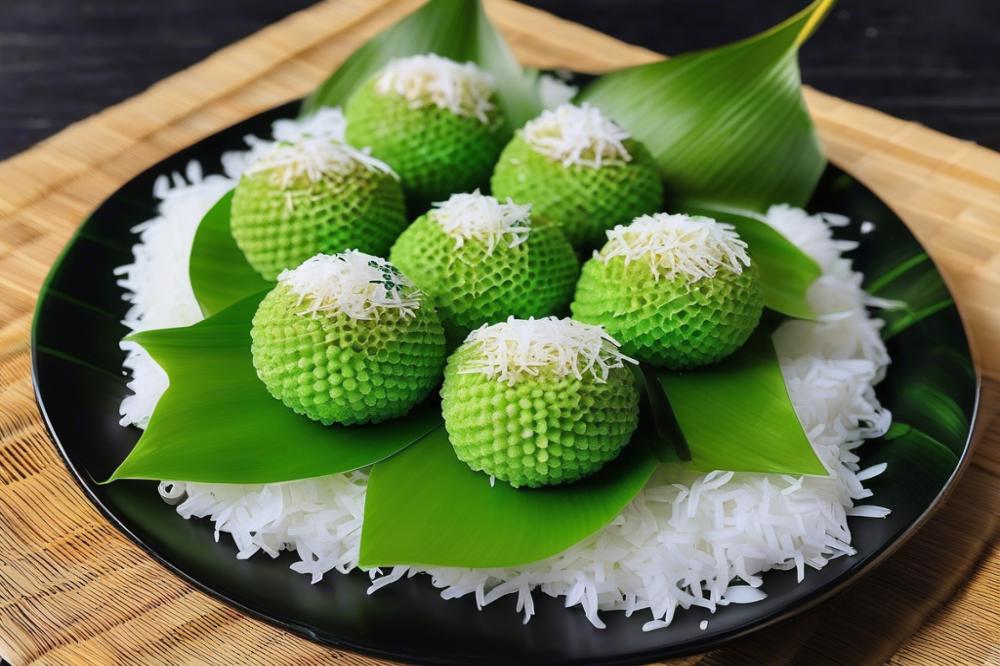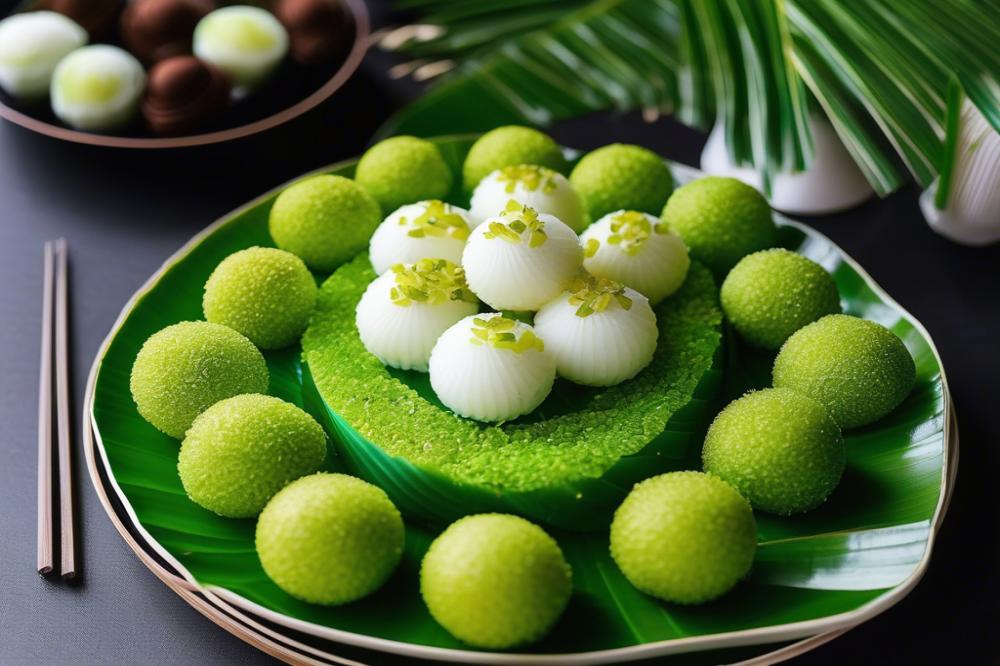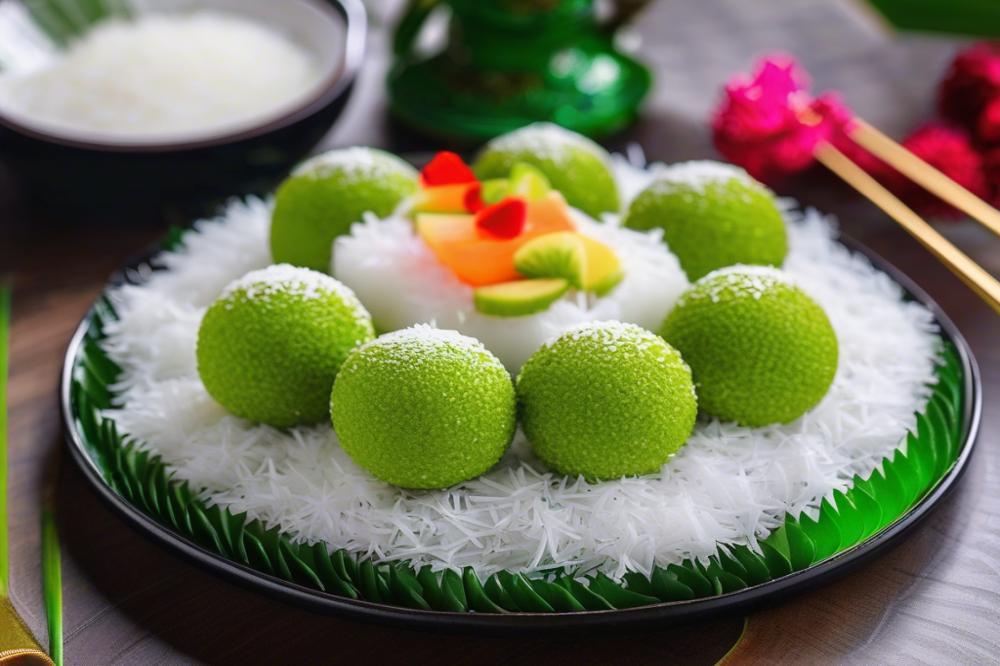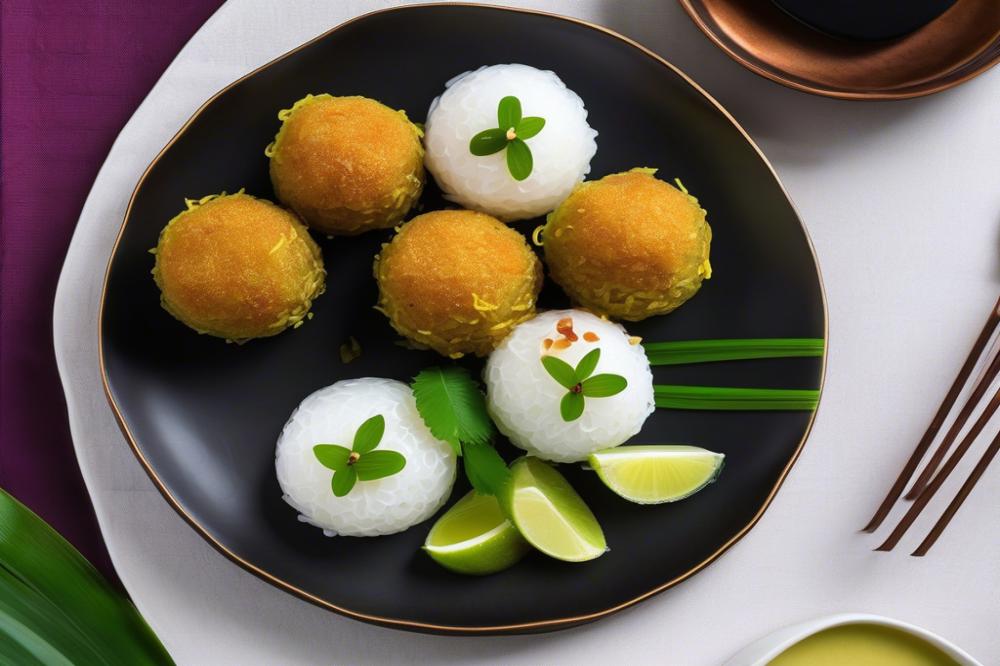Introduction
Kuih Ondeh-Ondeh is a beloved traditional Malaysian dessert that captures the essence of local cuisine. This sweet treat holds a special place at festive gatherings and celebrations. Celebrated for its delightful flavor and texture, it is often enjoyed during occasions like Hari Raya and weddings.
These glutinous rice balls have a chewy exterior that makes them truly satisfying to eat. Inside, a rich filling of Gula Melaka delivers a burst of sweetness upon biting into them. Each ball is rolled in freshly grated coconut, adding a wonderful contrast to the soft texture and enhancing the overall taste experience.
Using pandan leaves in the dough gives it a lovely green color and a subtle fragrance. This easy recipe allows anyone to explore the joys of making this delightful dessert at home. With each bite, you’ll discover why Kuih Ondeh-Ondeh continues to be a favorite for many, embodying the heart of Malaysian culture.
What is Kuih Ondeh-Ondeh

Historical Background and Cultural Significance
Kuih Ondeh-Ondeh has roots deeply embedded in Malaysian cuisine. This delightful dessert is often associated with festive occasions and celebrations. Traditionally, it is served during cultural events, symbolizing prosperity and joy. Families have passed down the recipe through generations, affirming its place in local heritage. This sweet treat brings people together, fostering a sense of community and warmth.
Description of Ingredients and Flavors
The main ingredients create a delightful combination of flavors. Glutinous rice flour forms the base of these chewy rice balls. They are filled with rich Gula Melaka, a type of palm sugar. This sugar melts when cooked, releasing a sweet syrupy burst that surprises the palate. The outer layer is often coated with shredded coconut, adding texture and a hint of saltiness to balance the sweetness. Each bite is a harmonious blend of taste and sensation.
The Role of Pandan in the Recipe
Pandan leaves play a crucial role in enhancing the flavor and aroma of this dessert. The vibrant green leaves are often used to infuse a subtle sweetness into the dough. Not only does pandan contribute to the flavor, but it also gives the rice balls a beautiful color. The aromatic scent of pandan elevates the overall experience, making it more enjoyable.
Why It Is a Popular Sweet Treat in Malaysia
Popularity stems from its unique taste and chewy texture. This dessert is not just a treat; it offers a taste of Malaysian culture. People of all ages enjoy Kuih Ondeh-Ondeh, making it a common sight at markets and gatherings. Accessibility also plays a part; many find it an easy recipe to try at home. Sharing this dessert during festivals and family events creates memorable moments. Its combination of flavors speaks to the hearts of many, making it beloved throughout the nation.
Ingredients and Cooking Instructions

Ingredients List
- 200g glutinous rice flour
- 100ml pandan juice (from fresh pandan leaves)
- 50g powdered sugar
- 150g Gula Melaka (palm sugar), chopped
- 100g grated coconut (fresh or desiccated)
- A pinch of salt
Step-by-Step Cooking Instructions
First, gather all ingredients. Begin by mixing the glutinous rice flour with the pandan juice and powdered sugar. This combination will create a vibrant green dough infused with the fragrant essence of pandan. It might seem dry at first; keep kneading until a smooth and pliable dough forms.
Next, take small portions of the dough and flatten them in your palm. Then, place a piece of chopped Gula Melaka in the center of each flattened piece. Carefully fold the edges over the sugar and roll it into a ball, making sure the filling is completely sealed inside. Focus on creating uniform shapes for an appealing presentation.
Prepare a pot of boiling water. Once the water is ready, gently drop the glutinous rice balls into it. Watch closely as they start to cook. The moment they float to the surface, you’ll know they are cooked through. This should take just a few minutes.
When cooked, remove the balls with a slotted spoon and transfer them to a plate. While they are still warm, roll them in grated coconut for a delightful coating. This step adds a lovely texture and enhances the sweet treat’s flavor. Serve these chewy delights warm, and enjoy the festive spirit that Malaysian cuisine brings with each bite!
Nutritional Information

When we break down the ingredients of this delightful dessert, we find a mix of nutritional values. Glutinous rice flour is the primary component. It provides carbohydrates, which give energy. Each serving contains a significant amount of calories due to the sugar content. Gula Melaka, or palm sugar, adds sweetness along with some vitamins and minerals like potassium.
Coconut plays a key role too. Fresh grated coconut is rich in fiber and healthy fats. It contributes to heart health when consumed in moderation. However, the high-fat content can be a concern if eaten in excess. People enjoy the rich flavor and creamy texture it gives to many dishes, especially during festive occasions.
Pandan enhances the dish with its aromatic essence. It has antioxidant properties that can support health. However, the intense sweetness can lead to weight gain if indulged too frequently. Balancing enjoyment and health is essential when treating oneself to sweet treats like these.
This easy recipe can cater to various dietary needs. For those who may have gluten intolerance, some substitutes can be explored to make a version that works for them. It is crucial to taste and find the right balance when making the filling, as the amount of gula Melaka can vary based on personal preference.
Texture contributes to the overall experience. These glutinous rice balls offer a chewy sensation that delights many. This combination of sweet and chewy creates an enticing mouthfeel. The contrast of the soft outer layer with the sugary center makes each bite a joy.
In Malaysian cuisine, these treats represent more than just a snack. They connect people to their culture and traditions. Eating Kuih Ondeh-Ondeh often becomes a cherished memory during family gatherings and festive celebrations. Each bite often brings nostalgia and joy, connecting generations through simple yet delicious food.
Tips for Making Perfect Kuih Ondeh-Ondeh
Achieving the Right Consistency of Dough
The dough for glutinous rice balls should be soft but not overly sticky. Start by mixing glutinous rice flour with a bit of water. Adding too much liquid will result in a mushy texture, while too little will make it dry and hard. Aim for a consistency that allows you to form smooth balls easily. Keep your hands slightly damp while shaping. This simple trick can prevent sticking and achieve a pleasing round shape.
Suggestions for Variations and Flavor Enhancements
While the traditional recipe calls for pandan flavoring, consider experimenting with other ingredients. You might infuse the dough with a bit of cocoa powder for a chocolate twist. Adding a hint of orange or lemon zest can brighten the flavor profiles, creating a refreshing complement to the sweetness. For those who enjoy richer textures, try folding in finely shredded coconut into the dough. This addition not only boosts taste but also enhances the chewy nature of the dessert.
Storage Tips and Best Practices for Serving
Storing your sweet treat properly is crucial for maintaining its texture. Place the glutinous rice balls in an airtight container if you plan to enjoy them later. They can stay fresh in the refrigerator for up to two days. When it’s time to serve, gently steam the balls to warm them, unlocking their delightful gooey center. If you plan to present this dish at a festive gathering, a sprinkle of grated coconut on top can add a lovely finishing touch. Delight your guests by serving the dish right after preparation, allowing them to enjoy the chewy goodness at its best.
Serving Suggestions
Pairing glutinous rice balls with beverages can enhance the experience. Consider serving them with hot tea. A fragrant jasmine tea complements the sweetness. Alternatively, try a cold coconut drink for a refreshing contrast. Fresh fruit juices can also refresh your palate.
Presentation tips for festive occasions
For a stunning dessert display, arrange the chewy rice balls on a vibrant platter. Using a banana leaf as a base adds a traditional touch. Sprinkle some shredded coconut around the edges for a pop of color. You could also elevate the appearance with decorative toothpicks. This technique makes it easy for guests to serve themselves. For special celebrations, consider placing them in small, decorative bowls.
Customizations for dietary preferences
This easy recipe is flexible enough for various dietary needs. To make a vegan version, simply avoid using any animal-based ingredients. The base ingredients are typically plant-based, which makes it simple. For those concerned about gluten, glutinous rice flour is naturally gluten-free. However, always check the packaging to be sure. Experimenting with flavors can add an exciting twist. Infusing the dough with different extracts or colors can make these treats stand out even more.
Final Thoughts on This Traditional Delight
Recapping the charm of these delightful glutinous rice balls, it becomes clear why they hold a special place in many hearts as a beloved dessert. The chewy texture combined with the burst of rich, sweet Gula Melaka creates an experience that is hard to forget. Each bite not only offers a treat for the taste buds but also evokes a sense of nostalgia, connecting many to their cultural roots.
Everyone should consider trying their hand at making this sweet treat at home. The process may seem daunting at first, but the satisfaction gained from creating these tasty morsels is immense. Gathering friends or family for a cooking session can turn a simple kitchen activity into a joyous gathering. As you roll the dough and fill each ball, you’ll feel a deeper connection to this culinary tradition.
Traditions like these indicate the importance of local desserts in preserving cultural heritage. Each recipe passed down through generations tells a story, reflecting the values and histories of those who came before us. By engaging in the practice of cooking such traditional foods, we keep these stories alive. Embracing these practices not only enriches our own lives but also strengthens our community bonds. So, don’t hesitate to explore the world of traditional sweets and savor every moment.



